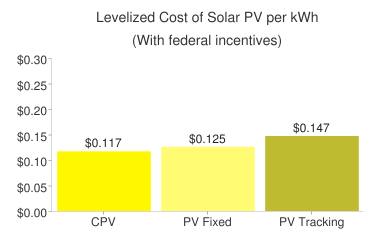 This post originally appeared on Energy Self-Reliant States, a resource of the Institute for Local Self-Reliance’s New Rules Project.
This post originally appeared on Energy Self-Reliant States, a resource of the Institute for Local Self-Reliance’s New Rules Project.
Concentrating solar typical fills people energy nerds with visions of large fields of mirrors focusing sunlight to make heat/steam/electricity, but concentration technology is also available for photovoltaics (PV). In fact, using lenses to focus sun onto PV cells – concentrated PV or CPV – may prove to be a more cost-effective (and compact) strategy of doing solar power than either concentrating solar thermal power or traditional solar PV.
For this analysis, we compared a real-life, 1 megawatt (MW) concentrated PV installation in Victorville, CA (just outside Los Angeles) to Southern California Edison’s 250 MW distributed PV installation (in 1-2 MW projects). Since SCE’s project likely involves fixed-tilt or flat PV panels, we also included a hypothetical ground-mounted single-axis tracking PV project for comparison.
The data suggests that CPV has a lower levelized cost of operation, even as both technologies have a levelized cost (with federal incentives) below the peak local retail electricity rate.
| CPV | PV Fixed Tilt | PV 1-axis tracking | |
|---|---|---|---|
| Installation size | 1 MW | ||
| Cost per Watt (AC) | $4.55 | $4.38 | $6.56 |
| Cost of capital | 5% | ||
| % debt financed | 80% | ||
| Debt term | 10 years | ||
| Project life | 25 years | ||
| Levelized Cost | |||
| Unsubsidized | $0.199 | $0.215 | $0.253 |
| With ITC/MACRS | $0.117 | $0.125 | $0.147 |
| Capacity factor | 24% | 17% | 22% |
The comparison is not just about lowest cost, because CPV offers other advantages. The concentrating lenses are less expensive that the actual solar cells, and thus CPV can potentially offer lower cost for the same kilowatt hour output. Additionally, a CPV can offer higher output per square foot of occupied space.
CPV appears to already be in a strong position to compete with traditional solar PV options, a promising position for a product just entering the commercial market.


